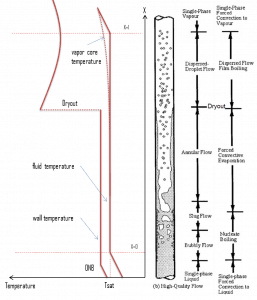At given combinations of flow rate through a channel, pressure, flow quality, and linear heat rate, the liquid wall film may exhaust, and the wall may be dried- out. At normal, the fuel surface is effectively cooled by boiling coolant. However, when the heat flux exceeds a critical value (CHF – critical heat flux), the flow pattern may reach the dry-out conditions (a thin film of liquid disappears). The heat transfer from the fuel surface into the coolant is deteriorated due to a drastically increased fuel surface temperature. In the high-quality region, the crisis occurs at a lower heat flux. Since the flow velocity in the vapor core is high, post-CHF heat transfer is much better than low-quality critical flux (i.e., for PWRs, temperature rises are higher and more rapid).
Typical flow boiling modes in a vertical channel are depicted in the figure. This figure shows the typical order of the flow regimes encountered from inlet to outlet of a heated channel. At the inlet, the liquid enters subcooled (at a lower temperature than saturation). In this region, the flow is single-phase. As the liquid heats up, the wall temperature correspondingly rises. As the wall temperature exceeds the saturation temperature (e.g., 285°C at 6.8 MPa), subcooled nucleate boiling begins. Bubbles nucleate in the superheated thermal boundary layer on the heated wall but tend to condense in the subcooled bulk.
Further increase in liquid temperature causes the liquid bulk to reach its saturation temperature, and the convective boiling process passes through the bubbly flow into the slug flow. Increasing void fraction causes the structure of the flow to become unstable. The boiling process passes through the slug and churns flow into the annular flow regime with its characteristic annular film of the liquid. At given combinations of flow rate through a channel, pressure, flow quality, and linear heat rate, the liquid wall film may exhaust, and the wall may be dried out. The wall temperature significantly rises at the dry-out point to dissipate the applied heat flux. The post-dry-out flow (mist or drop flow) in the heated channel is undesirable because such a flow regime is accompanied by significantly higher wall temperatures and high fluctuation of wall temperatures.
In this case, engineers define a parameter known as the minimum critical power ratio (MCPR) instead of DNBR. The critical power ratio (CPR) is used for determining the thermal limits of boiling water reactors.
Definition of CPR :
The CPR is that power in the assembly calculated by applying the appropriate correlation(s) to cause some point in the assembly to experience boiling transition, divided by the actual assembly operating power.
Special Reference: Tong, L. S., Weisman, Joel. Thermal Analysis of Pressurized Water Reactors. Amer Nuclear Society, 3rd edition, 5/1996. ISBN-13: 978-0894480386.